
Leonardo Loredan was a Venetian nobleman and statesman who reigned as the 75th Doge of Venice from 1501 until his death in 1521. A wartime ruler, his dogeship was one of the most important in the history of Venice. In the dramatic events of the early 16th century, Loredan's Machiavellian plots and cunning political manoeuvres against the League of Cambrai, the Ottomans, the Mamluks, the Pope, the Republic of Genoa, the Holy Roman Empire, the French, the Egyptians and the Portuguese saved Venice from downfall.
Caldogno is a town and comune near Vicenza in Italy. It has a population of 11,337 inhabitants.

Crocetta del Montello, formerly Crocetta Trevigiana, is a comune (municipality) in the Province of Treviso in the Italian region Veneto, located about 50 kilometres (31 mi) northwest of Venice and about 25 kilometres (16 mi) northwest of Treviso. As of 31 December 2004, it had a population of 5,807 and an area of 26.4 square kilometres (10.2 sq mi).
Orsago is a comune (municipality) in the Province of Treviso in the Italian region Veneto, located about 60 kilometres (37 mi) north of Venice and about 30 kilometres (19 mi) northeast of Treviso. As of 31 December 2004, it had a population of 3,817 and an area of 10.7 square kilometres (4.1 sq mi).
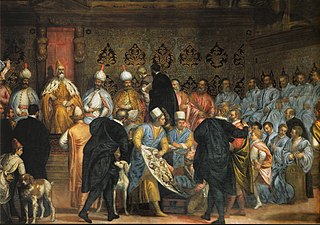
Carlo Cannovaro Caliari (1570–1596) was an Italian artist of the Renaissance period. He is also known as Carletto. The youngest son of Paolo Veronese, Caliari was active mainly in Venice, where he worked and inherited the studio of his far more famous father, and later worked along with his brother Gabriele and his uncle, Benedetto. His name is attached to several large pictures of banquets in Veronese's style. Alessandro Turchi worked briefly under him.

The House of Loredan is a Venetian noble family of supposed ancient Roman origin, which has played a significant role in shaping the history of the entire Mediterranean. A political dynasty, the family has throughout the centuries produced a number of famous personalities: doges, statesmen, magnates, financiers, diplomats, procurators, military commanders, naval captains, church dignitaries, writers, and lawyers.

Francesco Loredan was a Venetian statesman and magnate who served as the 116th Doge of Venice from 18 March 1752 until his death in 1762. He was a member of the noble House of Loredan, head of its Santo Stefano branch, and the only Doge, as well as the last male, to be awarded the Golden Rose by the Papacy.

Palazzo Giustinian Loredana S. Stin is a 16th-century palace of the Loredan family located in the San Polo district of Venice.
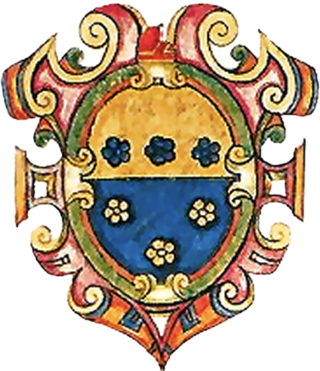
The House of Loredan-Santo Stefano was a cadet branch of the House of Loredan that existed from the 14th century until 1767. The branch was mainly settled in the Palazzo Loredan in Campo Santo Stefano, which they acquired in 1536 from the Mocenigo family. The progenitor of the branch is considered to be Gerolamo Loredan "dal Barbaro" di S. Vitale (d.~1474), father of Doge Leonardo Loredan and Dogaressa Caterina Loredan. Besides Leonardo, the branch also gave Doge Francesco Loredan.
Loredan is a Venetian surname. The House of Loredan is an aristocratic Venetian family that included various doges of the Republic of Venice, and the surname is almost exclusively associated with the family. The surname most likely originated from the toponym Loreo, which itself originated from its Latin name Lauretum, meaning laurel. Another theory of the origin of the surname, though most likely legendary, is that it comes from the Latin epithet Laureati, given to ancestors of the Loredan family due to their historical glory in ancient Rome and the many victories they achieved in battles. The surname is spelled Loredano or Loredan in Italian, Lauredano or Lauredanus in Latin, and Lorentano (Λορεντάνο) in Greek, though it is also historically found as Lordas (Λορδᾶς) and Lordano (Λορδάνο). The feminine name Loredana, common in Italy and Romania, was likely inspired by the surname.
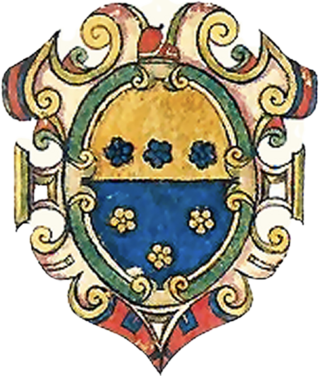
The House of Loredan-Santa Maria is a cadet branch of the noble House of Loredan which has produced many politicians, diplomats, military generals, naval captains, church dignitaries, writers and lawyers, and has played a significant role in the creation of modern opera with the Accademia degli Incogniti, also called the Loredanian Academy. The branch draws its name from the parishes of Santa Maria Formosa and Santa Maria dei Miracoli in Venice, around which it was historically settled. The progenitor of the branch is considered to be the famous admiral and procurator Pietro Loredan (1372-1438) by his sons Giacomo and Polo.

Villa Spineda Gasparini Loredan is an 18th-century Palladian style villa of the noble Loredan family located in the town of Volpago del Montello in the Veneto region of northeast Italy. It is regarded as one of the most beautiful villas of the Veneto.
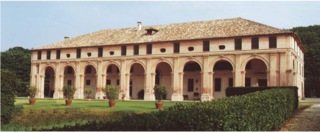
The Barchessa di Villa Bressa Loredan, known as the Palazzon, is a 16th-century Palladian barchessa of the Loredan family immersed in the vineyards of Volpago del Montello, but clearly visible from the Schiavonesca state road, between Montebelluna and Conegliano, to which it is connected by a long avenue of hazelnuts.

Villa Razzolini Loredan is a 17th-century villa located in Asolo in the Veneto region of northeast Italy, historically owned by the noble Razzolini and Loredan families.

The Villa Loredan at Stra is an early 16th-century villa of the noble Loredan family located in the town of Stra, on the Brenta river in the Veneto region of northeast Italy.

The Castle of Antiparos is a 15th-century castle located on the Greek island of Antiparos in the South Aegean. It was built in 1440 by the patrician Loredan dynasty from Venice, namely Giovanni Loredan, who owned the island and brought inhabitants to it at his own expense.

The Venetian patriciate was one of the three social bodies into which the society of the Republic of Venice was divided, together with citizens and foreigners. Patrizio was the noble title of the members of the aristocracy ruling the city of Venice and the Republic. The title was abbreviated, in front of the name, by the initials N.H., together with the feminine variant N.D.. Holding the title of a Venetian patrician was a great honour and many European kings and princes, as well as foreign noble families, are known to have asked for and obtained the prestigious title.
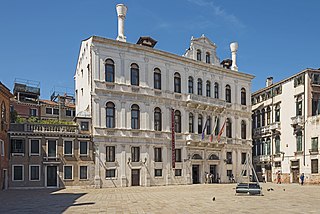
Palazzo Priuli Ruzzini Loredan, also called Palazzo Loredan at Campo Santa Maria Formosa, is a late 16th-century palace located at Campo Santa Maria Formosa in the Castello district of Venice, northern Italy, characterised by features of Renaissance and Baroque-style architecture on its façades.

The Villa Loredan at Carbonera, also known as Villa Loredan Valier Perocco, is a 17th-century aristocratic villa located in Vascon, a district of Carbonera in the northern Italian region of Veneto.
















